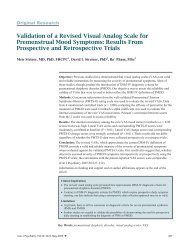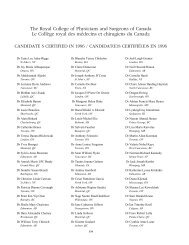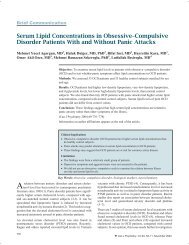The Canadian Journal of Psychiatry - Canadian Psychiatric ...
The Canadian Journal of Psychiatry - Canadian Psychiatric ...
The Canadian Journal of Psychiatry - Canadian Psychiatric ...
You also want an ePaper? Increase the reach of your titles
YUMPU automatically turns print PDFs into web optimized ePapers that Google loves.
<strong>The</strong> <strong>Canadian</strong> <strong>Journal</strong> <strong>of</strong> <strong>Psychiatry</strong>—Original Research<br />
Key Words: facial expression <strong>of</strong> emotions, mimic<br />
disturbance, psychopathology<br />
For a long time, clinical observations suggested a lack <strong>of</strong><br />
facial expressiveness in patients with schizophrenia. Further,<br />
occasional bizarre facial movements were already<br />
described by Kraepelin (1) and later defined as “mimic disintegration”<br />
by Heimann (2) and Spoerri (3) on the basis <strong>of</strong> systematic<br />
observation. Heimann and Spoerri describe the term<br />
“mimic desintegration”(in German, Mimische<br />
Desintegration) as mimic patterns that cannot obviously be<br />
assigned to any known productive expression, and an<br />
“impression <strong>of</strong> not belonging together and <strong>of</strong> alterations” (2,<br />
p 1128) is conveyed to the observer.<br />
Since Ekmans work, these mimic disturbances can be investigated<br />
empirically. Ekman postulates 6 basic emotions<br />
expressed through specific facial movements. <strong>The</strong>y can be<br />
identified with a video-based analyzing system called the<br />
FACS (4). <strong>The</strong>se 6 emotions are joy, disgust and contempt,<br />
aggression, sorrow, surprise, and anxiety. Each emotion is<br />
characterized by a specific pattern <strong>of</strong> “action units,” which are<br />
based on specific patterns <strong>of</strong> facial muscle activity. Integrated<br />
and organized mimic reactions in general are <strong>of</strong> great importance<br />
for social relations, with smiling being a key player in<br />
the expression <strong>of</strong> joy. <strong>The</strong>re are at least 3 types <strong>of</strong> smiles (5–<br />
7): the “felt smile” (caused by activation <strong>of</strong> M.zygomaticus<br />
plus M.orbicularis oculi), the social smile (activation <strong>of</strong><br />
M.zygomaticus alone), and the masking smile <strong>of</strong> the disgust<br />
or contempt type (caused by activation <strong>of</strong> M.zygomaticus plus<br />
M.levator labii). However, Ekman’s method <strong>of</strong> measuring<br />
Abbreviations used in this article<br />
CMRR<br />
COG<br />
CON<br />
DEP<br />
EMG<br />
EPS<br />
EXC<br />
FACS<br />
FEE<br />
IAPS<br />
NEG<br />
NS<br />
PANSS<br />
POS<br />
SCH<br />
SD<br />
common mode rejection ratio<br />
cognitive syndrome<br />
control<br />
depression<br />
electromyography<br />
Extrapyramidal Side Effects Scale<br />
hostile excitement<br />
Facial Action Coding System<br />
facial expression <strong>of</strong> emotions<br />
International Affective Pictures Scale<br />
negative syndrome<br />
not significant<br />
Positive and Negative Syndrome Scale<br />
positive syndrome<br />
schizophrenia<br />
standard deviation<br />
visible movements is limiting, and even microcomputerbased<br />
methods (8–10) do not solve these limitations.<br />
Modern EMG techniques provide a more precise measurement<br />
<strong>of</strong> the entire muscle activity, including the important<br />
previsible facial muscle actvity. Dimberg (11–14) was the<br />
first to prove the validity <strong>of</strong> the EMG method by matching<br />
EMG data to certain kinds and intensities <strong>of</strong> emotions. In<br />
addition, he was able to show the existence <strong>of</strong> “rapid facial<br />
reactions” (14).<br />
However, all EMG methods applied thus far fail to reach sufficient<br />
levels <strong>of</strong> both sensitivity and selectivity. In this context,<br />
selectivity means the ability <strong>of</strong> an EMG method to isolate<br />
the facial muscle targeted for measurement. Altogether, the<br />
more sensitive an EMG, the less selective it tends to be. For<br />
this reason, all previous EMG studies were unable to measure<br />
more than 2 to 3 facial muscles simultaneously.<br />
A new EMG method has become available, <strong>of</strong>fering sensitivity<br />
and selectivity at the same time. <strong>The</strong> new method facilitates<br />
the simultaneous measurement <strong>of</strong> 9 facial muscles. <strong>The</strong> validity<br />
<strong>of</strong> this method was recently established in 2 studies <strong>of</strong><br />
healthy subjects (15,16).<br />
This study aimed to use this improved EMG method to identify<br />
the well-known and indisputable mimic disturbances <strong>of</strong><br />
unmedicated schizophrenia patients.<br />
Unmedicated schizophrenia patients show a reduced<br />
frequency <strong>of</strong> joy (7,17), a preponderance <strong>of</strong> negative emotions<br />
(18), and a reduced mimic activity, especially <strong>of</strong> the<br />
upper face (19). In contrast, schizophrenia patients in remission<br />
show a reduced mimic activity, especially <strong>of</strong> the lower<br />
face (20). One study investigated an increased activity <strong>of</strong> the<br />
area around the nose, caused by the M.levator labii (21). A<br />
recent study investigated a reduced facial activity, especially<br />
in the upper face in acute schizophrenia patients and a stability<br />
<strong>of</strong> this pattern in the acute illness course and in remitted<br />
schizophrenia patients (22). EMG studies measuring the<br />
activity <strong>of</strong> M. zygomaticus and M. corrugator found a reduced<br />
activity <strong>of</strong> the smile muscle, M. zygomaticus, in unmedicated<br />
schizophrenia patients (19,23,24)<br />
Methods<br />
Subjects<br />
<strong>The</strong> sample group comprised 32 inpatients with schizophrenia<br />
(DSM-IV 295, SCH) and 21 healthy control subjects (CON).<br />
Of the SCH group, 28 were first-episode patients, 3 were<br />
second-episode patients, and 1 was a fourth-episode patient.<br />
<strong>The</strong> current evaluation is part <strong>of</strong> an ongoing extensive project<br />
about the longitudinal course <strong>of</strong> FEE in schizophrenia<br />
patients. Patients met DSM-IV criteria for schizophrenia (25)<br />
and had no other current diagnosis. All were inpatients, tested<br />
on the first day after admission. None <strong>of</strong> the patients had<br />
336<br />
Can J <strong>Psychiatry</strong>, Vol 51, No 6, May 2006







